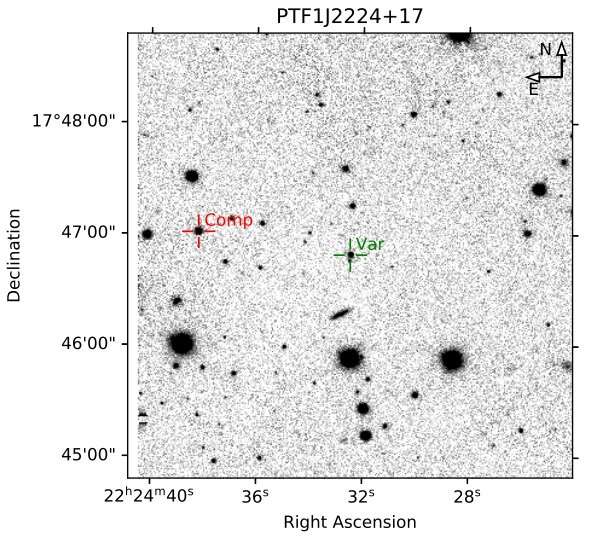June 4, 2020 report
PTF1J2224+17 is a polar, new study confirms

German astronomers have conducted photometric observations of a cataclysmic variable (CV) star known as PTF1J2224+17. Results of the observational campaign confirm that this object is a polar, as suggested by previous studies. The new findings are presented in a paper published May 27 on arXiv.org.
CVs are binary star systems comprising a white dwarf and a normal star companion. They irregularly increase in brightness by a large factor, then drop back down to a quiescent state. Polars are a subclass of cataclysmic variables distinguished from other CVs by the presence of a very strong magnetic field in their white dwarfs.
PTF1J2224+17 (or Ptf22 for short) is one of variable objects identified by the Palomar Transient Factory (PTF) survey. Follow-up observations of this source classified it as a CV, and as a polar candidate due to pronounced cyclotron line in its identification spectrum. However, the system's unusually short periodicity at a level of about 0.87 hours puts its assumed polar nature in doubt.
So Axel D. Schwope of Leibniz-Institute for Astrophysics Potsdam, Germany and Bernd Thinius of Inastars Observatory in Potsdam, Germany, performed time-resolved photometry of PTF1J2224+17. For this purpose, they employed the Inastars Observatory and analyzed archival data from PTF, Catalina Real-Time Transient Survey (CRTS) and the Zwicky Transient Facility (ZTF) survey, hoping to determine precisely the period of PTF1J2224+17, which could definitely confirm its polar classification.
"Triggered by the report of an unusually short periodicity in an obvious strongly magnetic cataclysmic variable by Margon et al. (2014), we obtained phase-resolved photometry during four nights in 2018 and 2019 with the aim to uniquely determine the underlying period," the astronomers wrote in the paper.
The study found that PTF1J2224+17 is variable on a period of approximately 103.82 minutes. The light curve of the source showcases a faint phase lasting nearly 70 percent of a cycle with little variability, and a bright phase hump that turned out to have a slightly different shape from cycle to cycle. The increase of brightness at the beginning of the bright phase seems to be steeper than the decrease toward the faint phase.
According to the paper, PTF1J2224+17 exhibits frequent changes between its high and low states. This, together with the estimated period and cyclotron humps found in the identification spectrum of PTF1J2224+17, allowed the researchers to confirm that the object is a polar.
Moreover, Schwope and Thinius assumed that PTF1J2224+17 has a magnetic field strength of around 65 MG. The accretion duty cycle in this system was measured to be about 35 percent, what is clearly shorter than in the prototype polar AM Herculis (about 50 percent).
In concluding remarks, the astronomers say that the study proves the importance of follow-up observations of such variables as PTF1J2224+17 in order to untangle their true nature.
"The analysis of such objects, in particular, attempts to find periodicities, still need dedicated photometric follow-up. For Ptf22, the problem lies in the frequent changes between high and low states that prevented to achieve a unique timing solution," the authors of the paper concluded.
More information: PTF1J2224+17: a short-period, high-field polar, arXiv:2005.13446 [astro-ph.SR] arxiv.org/abs/2005.13446
© 2020 Science X Network





















